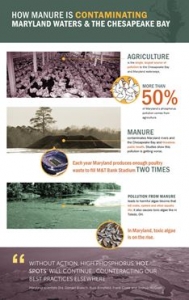Latest Version of Rules to Reduce Pollution by Better Controlling Manure Provide Several Exemptions for Farmers and a Six-Year Phase In
FOR IMMEDIATE RELEASE
December 1, 2014
Contact: Dawn Stoltzfus, The Hatcher Group, (410) 990-0284
(Annapolis, MD) – With today’s publication in the Maryland Register of new rules to better control manure, a coalition of nonprofit organizations called on the Maryland General Assembly to support the proposed Phosphorus Management Tool (PMT) regulation. A new phosphorus rule has been proposed three times in the last two years but has been repeatedly delayed due to pressure from industry lobbyists and legislative leaders.
Today a 30-day public comment period on the regulation begins, and the Maryland Administrative, Executive & Legislative Review committee has the opportunity to review and comment on them.
The Maryland Clean Agriculture Coalition says the latest version of the regulation includes a reasonable implementation plan for the state-of-the-art tool, as well as several exemptions for certain farms and a six-year phase-in timetable.
“Studies show phosphorus pollution is getting worse, not better – yet this regulation has been repeatedly delayed,” said Karla Raettig of the Maryland League of Conservation Voters. “It’s time for the Maryland legislature, with leadership from President Miller and Speaker Busch, to swiftly endorse them.”
The PMT would reduce pollution by limiting manure applied to farm fields already contaminated with excess phosphorus levels, and scientists say it would improve water quality, protect public health and reduce harmful algae blooms.
“Governor O’Malley kept his commitment to Marylanders and to the Chesapeake Bay by finalizing this much-needed rule to better manage manure,” said Joanna Diamond of Environment Maryland. “It’s time for the legislature to support this rule. This is one of the biggest opportunities to clean up the Chesapeake Bay and local waters in more than 30 years.”
Advocates cited concerns about continued delays to reduce phosphorus pollution, even as the state finalizes a renewed permit for concentrated animal feeding operations and counties approve hundreds of new, industrial-sized poultry houses on Delmarva. In 2013, Maryland’s poultry industry made $804 million in revenue. Advocates say the industry needs to help fund pollution clean-up costs and not expect small farmers or taxpayers to pay the full tab.
“The science is clear: we are dumping too much chicken poop on already saturated soils, while the poultry industry continues to rapidly expand,” said Bob Gallagher, Chair, West/Rhode Riverkeeper, Inc. “It makes no sense for Maryland to produce tons more poop until we have a plan to safely handle it and protect our waters.”
A recent report by the Environmental Integrity Project showed no improvement in phosphorus levels in eight major rivers on Maryland’s Eastern Shore over ten years, with pollution actually worsening in the Nanticoke, the Sassafras and the Transquaking Rivers.
In June, the Baltimore Sun reported on another study that concluded phosphorus produced by the Maryland poultry industry is increasing because of larger birds that produce more waste, and that phosphorus pollution has remained unchanged in nearly two-thirds of the rivers and streams tested and worsened in 16 percent.
Maryland’s 2010 Chesapeake Bay Watershed Implementation Plan (WIP) committed the state to updating the Phosphorus Management Tool in 2011. A study by the Chesapeake Bay Foundation found that failure to fully implement Maryland’s plan to restore the Chesapeake Bay would result in a $700 million annual loss.
According to BayStat, agriculture is the single, largest source of pollution to the Chesapeake Bay and Maryland waterways, and more than half of Maryland’s phosphorus pollution comes from farms. Phosphorus pollution causes algae blooms that threaten public health; kill underwater grasses; harm aquatic life like blue crabs, oysters and fish; and create an enormous “dead zone” in the Bay.
View the infographic “How Manure is Contaminating Maryland Waters & the Chesapeake Bay” as well as a fact sheet for more information about the Phosphorus Management Tool.
###
The Maryland Clean Agriculture Coalition is working to improve Maryland waterways and protect public health by reducing pollution, and increasing transparency and accountability, from agriculture and other associated sources of water degradation.
Anacostia Riverkeeper – Audubon Naturalist Society – Assateague Coastal Trust – Blue Water Baltimore – Chesapeake Climate Action Network – Clean Water Action – Common Cause Maryland – Environment Maryland –League of Women Voters of Maryland – Lower Susquehanna Riverkeeper – Maryland League of Conservation Voters – Maryland Pesticide Network – National Wildlife Federation, Mid-Atlantic Regional Center – Potomac Riverkeeper – Sierra Club, Maryland Chapter – South River Federation – Waterkeepers Chesapeake – West/Rhode Riverkeeper
Download this press release (PDF)

